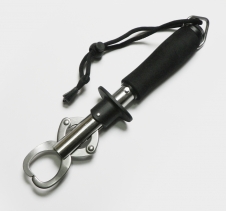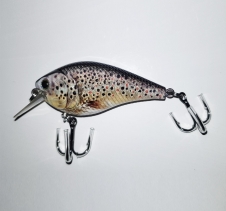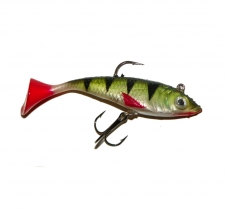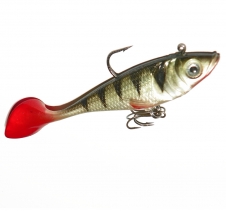Visit Our Online Store! $7 AusPost Parcel Post Delivery FREE Postage for orders $45 and over!
* Shipping rates above apply to Australian Customers only
Introduction to Yellowbelly / Golden Perch Fishing.
Golden Perch information, locations, baits, lures and hook sizes
.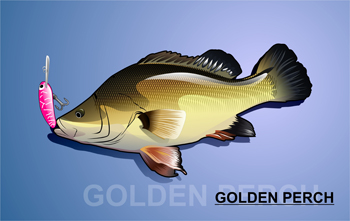 Golden perch are a large fish with a rounded body, the top of the fish can be green to light brown, while the lower section "the belly" is yellow. This gave them the name yellowbelly to early fishermen, and although their official name was once "callop", yellowbelly and golden perch are the two official names since the 1950's. They are mainly found in the Murray River, along with in joining streams and lakes within the Murray Darling system in Victoria and New South Wales. Can also been found in the Dawson and Mary Rivers in Queensland, along with Cooper Creek in South Australia.
Golden perch are a large fish with a rounded body, the top of the fish can be green to light brown, while the lower section "the belly" is yellow. This gave them the name yellowbelly to early fishermen, and although their official name was once "callop", yellowbelly and golden perch are the two official names since the 1950's. They are mainly found in the Murray River, along with in joining streams and lakes within the Murray Darling system in Victoria and New South Wales. Can also been found in the Dawson and Mary Rivers in Queensland, along with Cooper Creek in South Australia.When targeting them for fishing, the Murray River is a common location, especially . They can also be found in some lakes throughout Victoria and New South Wales as they are stocked by the state for recreational fishing. Some popular locations include:
• Hume Weir / Lake Hume in Albury, NSW/VIC
• Lake Windamere near Mudgee in NSW
• Lake Eildon, Victoria.
Most fish caught will be around 2kg, although they have been cited as caught to 12kg in NSW back in the 1960's, the modern offical record is 9kg. Details exist of a fish caught in Victoria in the early 1900s being 25kg in size, however the accuracy of sources for this event are inconclusive.
The easiest way to fish for golden perch is in lakes by kayak or a small aluminium boat (known as a tinnie). In lakes the fish normally group together during colder weather and depending on the water temperature, will move to different parts of the waterbody. They can be tracked down in this manner when using a kayak or small boat, where as fishing for them from the shoreline can be a hit and miss.
In rivers they can be caught in both the main current and slower side waters, though most appear to prefer the slower waters. The good thing about rivers is they can be caught either by boat or from the shoreline with relatively similar success, although catching in rivers is not a common occurance. It is usually best to expect a catch such as a few redfin, while hoping to catch a yellowbelly.
Special equipment is not required for them, however it is advised that when bait or spin fishing for them, a 10lbs line is used. The best rig is usually a simple light running sinker setup with 3 foot leader on a hook ranging from size 1/0 or 2/0 if you are targeting fish of around 2kg. The best baits are yabbies, scrubworms, earthworms and raw prawns, usually in that order. Yabbies can be rigged as live bait with a hook through the top of the body exiting upwards from the flesh infront of the tail, if the yabbie is dead they can be hooked through the front of the body, running the hook through the middle of the body and exiting with the hook facing downwards before the start of the tail.
They can also be caught using lures, the best lures are spin lures / spinnerbaits, hard body lures and blade lures.
Golden perch will not attack as fast or often as the european / redfin perch, so patience when fishing for them is required. When they do attack though, it is normally a very strong hit which is easy to indicate when the hook has to be set.
The best way to lure fish for yellowbelly is to get a lure to the bottom of the water column, lightly touching the bottom then cause some movement with a small rise up to a maximum of about 1 foot or less, before touching the bottom again, this is the easiest way to provoke a strike from a yellowbelly.
There are two ways to fish for yellowbelly once your lure in on the bottom. The lure can either swim along the bottom, or sit in one general position with lots of movement. Most yellowbelly will sit in ambush at the bottom of the water column, and will rarely attack a lure in the middle to top of the water.
Using sinking lures is best, otherwise diving hard bodies with a deep depth ability to get along the bottom of the water is a requirement. Even if your lure isn't a sinking type, a trick to use with a hard body lure is to attach a weight to the front of the lure or a running sinker along a very small section of the final length of fishing line, between a swivel and the attachment to the front of the lure, after this you can then use the weight to sit the lure in one general position on the bottom, nose down / tail up, then put a lot of movement through the fishing line to draw attention to your lure at the bottom, and kick up some bottom debris which will alert nearby yellowbelly to your lure location.
Follow us on twitter: @FishTackleLures or Google Plus: +FishingTackleLuresAU
View more articles in our Australian Fishing Guide.
Enter your email address below to be updated on new fishing articles, fishing lures and special offers:
We will only email once every two to four weeks at the most, usually every 2 months.
POPULAR PRODUCTS IN OUR ONLINE STORE


